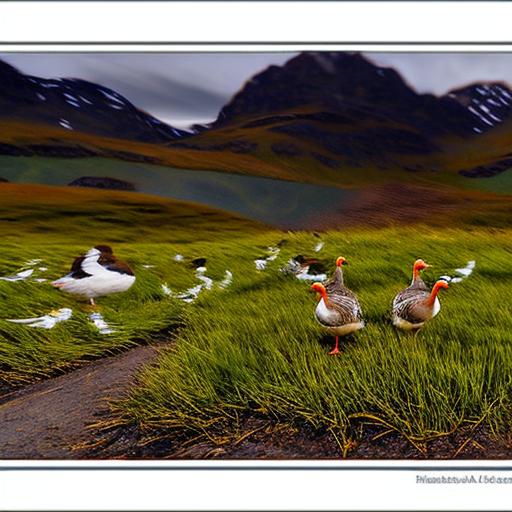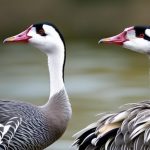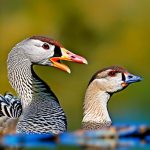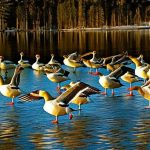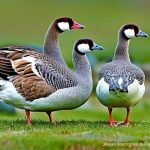Geese have a long history in Alaska, dating back to the time when indigenous peoples relied on them for food and clothing. Today, keeping geese in Alaska is not only a way to connect with this rich cultural heritage, but also offers numerous benefits. Geese are hardy birds that can thrive in the harsh Alaskan climate, providing a sustainable source of meat, eggs, and down feathers. Additionally, they can serve as effective guardians of property, alerting owners to potential threats with their loud honking.
Key Takeaways
- Keeping geese in Alaska can be a rewarding and profitable venture.
- The harsh Alaskan climate requires special considerations for raising geese.
- Choosing the right breed of geese is crucial for their survival in Alaskan climates.
- Proper housing and fencing are necessary to protect geese from predators and the elements.
- Feeding and watering geese in Alaska requires attention to their nutritional needs and access to unfrozen water.
Climate Considerations for Raising Geese in Alaska
Alaska is known for its extreme weather conditions, with long, cold winters and short, mild summers. These temperature and weather patterns can pose challenges for raising geese. However, with proper preparation and care, geese can adapt and thrive in this environment. It is important to provide adequate shelter and protection from the elements during the winter months. This can be achieved by insulating the housing structures and providing ample bedding material for the geese to keep warm. Additionally, it is crucial to have a plan in place for extreme weather events such as blizzards or heavy snowfall.
Choosing the Right Breed of Geese for Alaskan Climates
When selecting geese breeds for Alaska, it is important to choose those that are well-suited to the cold climate and have a high tolerance for extreme temperatures. Some popular breeds for Alaska include the Toulouse, Embden, and Chinese breeds. The Toulouse breed is known for its large size and calm temperament, making it a popular choice for meat production. The Embden breed is also large and hardy, with a reputation for being good egg layers. The Chinese breed is smaller in size but has excellent meat quality and is known for its ability to withstand cold temperatures.
Housing and Fencing Requirements for Geese in Alaska
Proper housing and fencing are essential for keeping geese safe and secure in Alaska. Geese require a sheltered area to protect them from the elements, especially during the winter months. Housing structures can range from simple sheds to more elaborate structures with insulated walls and roofs. It is important to provide adequate ventilation while also ensuring that the geese are protected from drafts.
Fencing is necessary to keep geese contained and protect them from predators. The type of fencing needed will depend on the size of the property and the potential threats in the area. Electric fencing can be an effective deterrent for predators such as foxes or coyotes. It is important to regularly inspect and maintain the fencing to ensure its effectiveness.
Feeding and Watering Geese in Alaska
Feeding geese in Alaska requires careful consideration of their nutritional needs, especially during the winter months when forage may be limited. A balanced diet for geese should include a mix of grains, greens, and protein sources. It is important to provide a constant supply of fresh water, even in freezing temperatures. This can be achieved by using heated waterers or by regularly breaking ice on existing water sources.
Health and Veterinary Care for Geese in Alaska

Geese in Alaska may face unique health challenges due to the extreme climate and remote locations. Common health issues for geese in Alaska include frostbite, respiratory infections, and parasites. It is important to monitor the health of the geese regularly and seek veterinary care when necessary. Finding a veterinarian in remote areas can be challenging, but there are resources available such as mobile veterinary clinics or telemedicine consultations.
Geese Behavior and Socialization in Alaskan Environments
Understanding geese behavior is crucial for successful goose keeping in Alaska. Geese are social animals that thrive in groups, so it is important to provide them with companionship. They are also territorial and will defend their territory and flock from perceived threats. Socializing geese from a young age can help them become more comfortable around humans and other animals.
Egg Production and Incubation for Geese in Alaska
Encouraging egg production in geese requires providing them with a suitable nesting area and a balanced diet. Geese typically lay their eggs in the spring, so it is important to provide them with a safe and comfortable nesting area during this time. Incubation of goose eggs can be done naturally by allowing the geese to sit on the eggs or through artificial incubation. It is important to monitor the temperature and humidity levels during incubation to ensure successful hatching.
Raising Goslings in Alaska: Tips and Tricks
Raising goslings in Alaska requires extra care and attention due to the cold temperatures. It is important to provide them with a warm and dry environment, as well as supplemental heat if necessary. Goslings should be kept indoors until they are fully feathered and able to regulate their body temperature. Providing them with a balanced diet that meets their nutritional needs is also crucial for their growth and development.
Selling Geese and Goose Products in Alaskan Markets
There is a growing market for geese and goose products in Alaska, with demand for meat, eggs, and down feathers. Marketing and selling these products can be done through local farmers markets, online platforms, or direct sales to restaurants or individuals. It is important to highlight the unique qualities of Alaskan-raised geese, such as their hardiness and ability to thrive in extreme climates. Additionally, offering value-added products such as goose pate or down pillows can help differentiate your products in the market.
If you’re interested in keeping geese in Alaska, you might also want to check out this informative article on poultrywizard.com about the Chicken Coop Country Diner. It provides valuable insights into creating a comfortable and functional space for your geese. Additionally, poultrywizard.com offers a wide range of resources and tips for poultry enthusiasts, including the Producers Pride Sentinel Chicken Coop, which could be adapted for geese as well. So, whether you’re a beginner or an experienced poultry keeper, poultrywizard.com has got you covered. (source)
FAQs
What are the benefits of keeping geese in Alaska?
Geese can provide a source of meat, eggs, and feathers. They can also help control pests and weeds in gardens and fields.
What are the challenges of keeping geese in Alaska?
The harsh winter weather can be a challenge for geese, as they need access to water and shelter from the cold. Predators such as foxes, coyotes, and eagles can also pose a threat.
What breeds of geese are best suited for Alaska?
Breeds that are hardy and cold-tolerant, such as Toulouse, Embden, and Pilgrim geese, are well-suited for Alaska.
What kind of housing do geese need in Alaska?
Geese need a shelter that is dry, draft-free, and well-ventilated. They also need access to water for swimming and drinking.
What do geese eat in Alaska?
Geese can eat a variety of foods, including grass, grains, and vegetables. They also need access to clean water for drinking and swimming.
Do geese need to be protected from predators in Alaska?
Yes, geese are vulnerable to predators such as foxes, coyotes, and eagles in Alaska. It is important to provide them with a secure shelter and to supervise them when they are outside.
What kind of care do geese need in Alaska?
Geese need regular access to clean water, food, and shelter. They also need protection from predators and regular health checks to ensure they are healthy.
Meet Walter, the feathered-friend fanatic of Florida! Nestled in the sunshine state, Walter struts through life with his feathered companions, clucking his way to happiness. With a coop that’s fancier than a five-star hotel, he’s the Don Juan of the chicken world. When he’s not teaching his hens to do the cha-cha, you’ll find him in a heated debate with his prized rooster, Sir Clucks-a-Lot. Walter’s poultry passion is no yolk; he’s the sunny-side-up guy you never knew you needed in your flock of friends!

